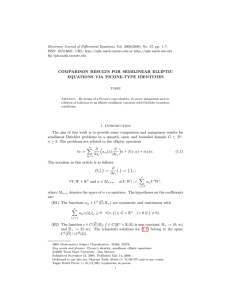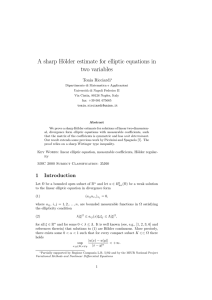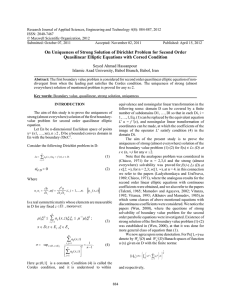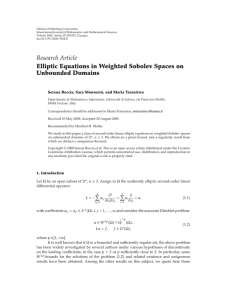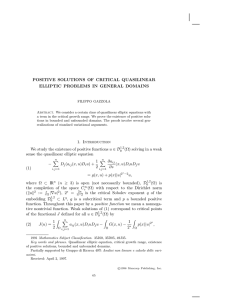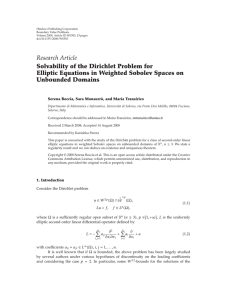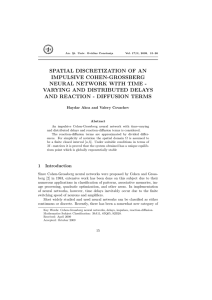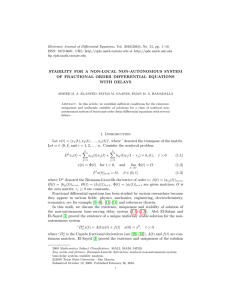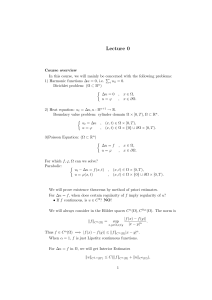Lecture 20 Difference Quotients and Sobolev spaces April 29th, 2004
advertisement
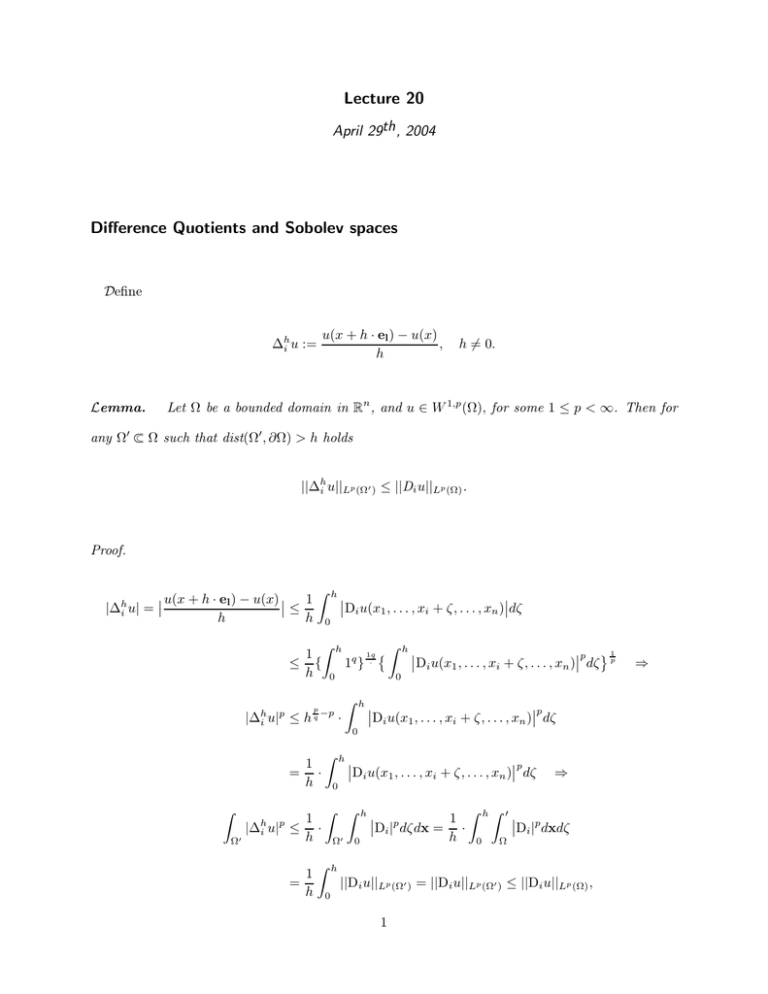
Lecture 20
April 29th , 2004
Difference Quotients and Sobolev spaces
Define
u(x + h · el ) − u(x)
,
h
∆hi u :=
Lemma.
h 6= 0.
Let Ω be a bounded domain in Rn , and u ∈ W 1,p (Ω), for some 1 ≤ p < ∞. Then for
⊂ Ω such that dist(Ω′ , ∂Ω) > h holds
any Ω′ ⊂
||∆hi u||Lp (Ω′ ) ≤ ||Di u||Lp (Ω) .
Proof.
|∆hi u|
u(x + h · el ) − u(x) 1
≤
=
h
h
Z
h
Di u(x1 , . . . , xi + ζ, . . . , xn )dζ
0
Z h
Z
h
1
1
q 1q
Di u(x1 , . . . , xi + ζ, . . . , xn )p dζ p
·
1 }
≤ {
h 0
0
p
|∆hi u|p ≤ h q −p ·
=
Z
Ω′
|∆hi u|p ≤
=
1
·
h
Z
1
·
h
Z
1
h
Z
Z
h
0
Ω′
h
0
Di u(x1 , . . . , xi + ζ, . . . , xn )p dζ
Di u(x1 , . . . , xi + ζ, . . . , xn )p dζ
Z
h
0
p
Di | dζdx = 1 ·
h
Z
h
0
Z
⇒
′
Ω
p
Di | dxdζ
h
0
||Di u||Lp (Ω′ ) = ||Di u||Lp (Ω′ ) ≤ ||Di u||Lp (Ω) ,
1
⇒
where we applied Fubini’s Theorem in order to switch order of integration.
Conversely we have
Lemma.
Let u ∈ Lp (Ω) for some 1 ≤ p < ∞ and suppose ∆hi u ∈ Lp (Ω′ ) with ||∆hi u||Lp (Ω′ ) ≤ K
⊂ Ω and 0 < |h| < dist(Ω′ , Ω). Then the weak derivative satisfies ||Di u||Lp (Ω) ≤ K.
for all Ω′ ⊂
Consequently if this holds for all i = 1, . . . , n then u ∈ W 1,p (Ω).
Proof. We will make use of
Alouglou’s Theorem.
A bounded sequence in a separable, reflexive Banach space has a weakly
convergent subsequence.
A topological space is called separable if it contains a countable dense set.
A Banach space is called reflexive if (B ⋆ )⋆ = B.
A sequence {xn } in a Banach space is said to converge weakly to x when lim F (xn ) → F (x) for
n→∞
all linear functionals F ∈ B ⋆ . This is sometimes denoted lim xn ⇀ x.
n→∞
2
n
Example: Let ℓ := (a1 , a2 , . . .) :
∞
X
i=1
o
a2i < ∞ . Consider the sequence {xi := (0, . . . , 0, 1, 0, . . .)}
⊆ ℓ2 . Any bounded linear functional on ℓ2 will be some linear combination of the linear functionals
Fj , defined by Fj (a1 , . . .) = aj (each such linear combination corresponds exactly to a point in ℓ2 .
That makes sense, indeed by the Riesz Representation Theorem (ℓ2 )⋆ = ℓ2 (note ℓ2 is a Hilbert
space not just a Banach space as it has an inner product structure).). For any such F = (a1 , . . .),
lim F (xi ) = lim ai = 0. So xi converges to the 0 vector weakly, though certainly not strongly:
i→∞
i→∞
by Fourier Theory each point in ℓ2 corresponds to a periodic function on [0, 1], i.e an element of
√
L2 (S 1 ), and of course lim exp(n2π −1z) 6→ 0(z).
n→∞
2
We come back to the proof. For the Banach space B = Lp (Ω), B ⋆ = Lq (Ω) with
This can be seen directly: If F ∈ (Lp (Ω))⋆ , then exists f such that F (g) =
R
Ω
g · f,
1
1
+ = 1.
p
q
∀g ∈ Lp (Ω),
and this will be bounded iff f ∈ Lq (Ω). So we get an identification F ∈ (Lp (Ω))⋆ ∼
= Lq (Ω).
By Alouglou’s Theorem there exists a sequence {hm } → 0 with ∆hi m u ⇀ v ∈ Lp (Ω). In other
words
Z
Ω
∆hi m u
ψ·
→
Z
Ω
ψ · v ∈ Lp (Ω),
∀ ψ ∈ Lq (Ω).
And in particular for any ψ ∈ C01 (Ω) (which is dense in Lq (Ω) so will suffice to look at such ψ as
will become clear ahead)
Z
Ω
ψ∆hi m u
=
1
ψ (u(x + h · el ) − u(x))dx
Ω h
Z
1
=
h
=
Z
Z
ψ(x)u(x)dx
Ω
Z
1
(ψ(x − hei ) − ψ(x))u(x)dx
h
Z
−∆hi ψ(x)u(x)dx
Ω
=
1
ψ(x − hei )u(x)dx −
h
Ω
Ω
h→0
−→
Z
−Di ψ(x)u(x)dx
Ω
since ψ is continuously differetiable. Altogether
Z
Ω
p
ψ · v ∈ L (Ω) =
Z
Ω
−Di ψ(x)u(x)dx,
which by definition means v is the weak derivative of u in the direction of the xi axis, or simply
the undistinctive notation v = Di u.
We also get the desired estimate, using the Fatou Lemma
Z
p
Ω
|Di u| dx =
Z
lim inf
Ω
|∆hi u|p dx
i.e ||Di u||Lp (Ω) ≤ K.
3
R
≤ lim inf
lim inf ≤ lim inf
Z
Ω
R
|∆hi u|p dx ≤ K p ,
L2 Theory
Consider the second order equation in divergence form
Lu ≡ L(u) := Di (aij Dj u) + bi Di u + c · u = f,
with aij , bi , c ∈ L1 (Ω) (integrable coefficients).
We call u ∈ W 1,2 (Ω) a weak solution of the equation if
∀ v ∈ C01 (Ω)
−
Z
aij Dj uDi v +
Ω
Z
(bi Di u + cu)v =
Ω
Z
f v.
Ω
Elliptic Regularity
Let u ∈ W 1,2 (Ω) be a weak solution of Lu = f in Ω, and assume
•
L strictly elliptic with (aij ) > γ · I, γ > 0
•
aij ∈ C 0,1 (Ω)
•
bi , c ∈ L∞ (Ω)
•
f ∈ L2 (Ω)
⊂ Ω, u ∈ W 2,2 (Ω′ ) and
Then for any Ω′ ⊂
||u||W 2,2 (Ω′ ) ≤ C(||aij ||C 0,1 (Ω) , ||b||C 0 (Ω) , ||c||C 0 (Ω) , λ, Ω′ , Ω, n) · ||u||W 1,2 (Ω) + ||f ||L2 (Ω) .
Note L∞ (Ω) stands for bounded functions on Ω while C 0 (Ω) are functions that are also continuous
(Ω being bounded).
Proof. Start with the definition of u being a solution in the weak sense, ∀ v ∈ C01 (Ω):
4
Z
aij Dj uDi v =
Z
Ω
Ω
(bi Di u + c − f )v.
and take difference quotients, that is replace v with ∆−h v.
Z
aij Dj uDi (∆−h v) =
Z
Ω
Ω
(bi Di u + c − f )(∆−h v).
Taking −h is a technicality that will unravel its reason later on, and we really mean ∆−h
k v for
some k ∈ {1, . . . , n} and then eventually repeat the computation for all k in that range. This
will become clear as well. Finally our goal will be to use the Chain Rule and move the difference
quotient operator onto u under the integral sign and get uniform bounds on ∆h Du and in this way
get a priori W 2,2 (Ω) estimates.
The Chain Rule gives
∆h (aij Dj u) =
1 ij
a u(x + h · ek )Dj u(x + h · ek ) − {aij (x) − aij (x + h · ek ) + aij (x + h · ek )}Dj u(x)
h
= aij u(x + h · ek )∆h Dj u − ∆h aij Dj u.
And applied to our previous equation, a short calculation verifies that we can ’integrate by part’
wrt ∆h –
Z
Z
Z
aij Dj uDi (∆−h v) =
Ω
Ω
∆h (aij Dj u)Di v
Ω
Ω
ij
Z
h
a u(x + h · ek )∆ Dj uDi v =
Z
Ω
⇒
−∆h aij Dj uDi v +
Z
Ω
(bi Di u + c − f )(∆−h v)
⇒
aij u(x + h · ek )∆h Dj uDi v ≤ ||∆h aij Dj u||L2 (Ω) ||Di v||L2 (Ω) +
+ ||bi Di u + cu − f ||L2 (Ω) ||∆−h v||L2 (Ω) ,
5
where we have used the Hölder Inequality for p = q = 2. This in turn can be bounded by
≤ ||aij ||C 0,1 (Ω) ||Du||L2 (Ω) ||Dv||L2 (Ω) +
+ ||bi ||L∞ (Ω) ||Du||L2 (Ω) + ||c||L∞ (Ω) ||u||L2 (Ω) + ||f ||L2 (Ω) ||Dv||L2 (Ω)
≤ C(||u||W 1,2 (Ω) + ||f ||L2 (Ω) ) · ||Dv||L2 (Ω) .
where we have used the Hölder Inequality for p = 1, q = ∞, i.e a simple bounded integration
Z
Z
1
1
argument (e.g ||cu||L2 (Ω) =
|u|2 2 ), and ∆h aij → Dk aij as aij C 0,1 (Ω).
c2 · |u|2 2 ≤ sup |c|2
O
Take a cut-off function η ∈ C01 (Ω), 0 ≤ |η| ≤ 1, η Ω′ = 1. We now choose a special v: v := η 2 ∆h u.
From uniform ellipticity (aij ζi ζj ≥ λ|ζ|2 )
λ
Z
h
Ω
2
|ηD∆ u| ≤
Z
Ω
η 2 aij (x + h · ek )Di ∆h uDj ∆h u.
Now
Di v = 2ηDi η∆h u + η 2 Di ∆h u
which we substitute into our previous inequality,
Z
2 ij
Ω
h
h
η a (x + h · ek )Dj ∆ uDj ∆ u ≤
Z
Ω
aij (x + h · ek )Dj ∆h u · (Di v − 2ηDi η∆h u)
≤ C(||u||W 1,2 (Ω) + ||f ||L2 (Ω) )||Dv||L2 (Ω) +
+ C ′ ||(D∆h u)η||L2 (Ω) ||Dη∆h u||L2 (Ω)
again by the Hölder Inequality. Now since η ≤ 1
||Di v||L2 (Ω) ≤ C ′′ ||Di η∆h u||L2 (Ω) + ||D∆h u||L2 (Ω) .
Combining all the above and again using η ≤ 1,
6
λ
Z
′
Ω
|ηD∆h u|2 ≤ C ||u||W 1,2 (Ω) + ||f ||L2 (Ω) · C ′′ ||Dη∆h u||L2 (Ω′ ) + ||D∆h u||L2 (Ω′ )
+ C ′ ||(D∆h u)||L2 (Ω′ ) ||Dη∆h u||L2 (Ω′ )
≤ c ||u||W 1,2 (Ω) + ||f ||L2 (Ω) + ||Dη∆h u||L2 (Ω′ ) · ||(D∆h u)||L2 (Ω′ )
+ c ||u||W 1,2 (Ω) + ||f ||L2 (Ω) · ||Dη∆h u||L2 (Ω′ ) .
Using the AM-GM Inequality ab =
r
1 2
1 1 2
a · ǫb2 ≤
a +ǫb2 for the first term and the inequality
ǫ
2 ǫ
(a + b)c ≤ 12 (a + b + c)2 for the second
λ
Z
Ω′
|ηD∆h u|2 ≤
2
1 2
c ||u||W 1,2 (Ω) + ||f ||L2 (Ω) + ||Dη∆h u||L2 (Ω′ ) + ǫ||(D∆h u)||2L2 (Ω′ )
ǫ
2
+ c ||u||W 1,2 (Ω) + ||f ||L2 (Ω) + ||Dη∆h u||L2 (Ω′ ) .
Choose any 0 < ǫ < λ/2. Then subtract the second term on the first line of the rhs from the
lhs to get
||ηD∆h u||2L2 (Ω′ ) ≤ c ||u||W 1,2 (Ω) + ||f ||L2 (Ω) + ||Dη∆h u||L2 (Ω′ )
2
||ηD∆h u||L2 (Ω′ ) ≤ c ||u||W 1,2 (Ω) + ||f ||L2 (Ω) + ||Dη∆h u||L2 (Ω′ )
⇒
≤c ||u||W 1,2 (Ω) + ||f ||L2 (Ω) + sup |Dη| · ||∆h u||L2 (Ω′ )
Ω
≤c ||u||W 1,2 (Ω) + ||f ||L2 (Ω) · 1 + sup |Dη| ,
Ω
since ||∆h u||L2 (Ω) ≤ ||Du||L2 (Ω) ≤ ||u||W 1,2 (Ω) ≤ ||u||W 1,2 (Ω) + ||f ||L2 (Ω) where we have applied the
first Lemma to u ∈ W 1,2 (Ω). Now we are done as we can choose η such that first η Ω′ = 1 (for the
lhs !) and second |Dη| ≤ dist(Ω′ , ∂Ω) (for the rhs ) and so
||1 · D∆h u||2L2 (Ω′ ) ≤ c ||u||W 1,2 (Ω) + ||f ||L2 (Ω) ,
7
independently of h. So by our second Lemma the uniform boundedness of the difference quotients
of Du in L2 (Ω′ ) implies Du ∈ W 1,2 (Ω′ )
⇒
u ∈ W 2,2 (Ω′ ) and we have the desired estimate for
its W 2,2 (Ω′ ) norm by the above inequality combined with the Lemma.
Now that u ∈ W 2,2 (Ω′ ) then the our original equation holds in the usual sense
Lu = aij Di ju + Di aij Dj u + bi Di u + c · u = f,
a.e !
8
